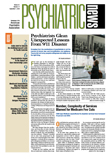Patients with severe mental illness commit approximately 1 in 20 violent crimes, according to a study of mental illness and violence in Sweden.
Researchers using Swedish national registry data determined that the overall contribution of patients with severe mental illness to violent crime in Sweden between 1988 and 2000 was about 5 percent.
“Although Sweden is average for Western Europe in terms of violent crime per head of population, it has lower rates of homicides than countries with more liberal gun-ownership laws,” wrote study authors Seena Fazel, M.B.Ch.B., and Martin Grann, C.Psych. Ph.D., in the August American Journal of Psychiatry. “This will alter the attributable risk for homicide, which is likely to be lower in countries such as the United States, but it is unlikely to substantially modify the overall attributable risk for violent crime, which is mostly accounted for by much more common crimes, such as assault.”
They linked 98,082 individuals discharged with an ICD diagnosis of schizophrenia to a national crime registry to determine the population-attributable risk of patients with severe mental illness to violent crime. Population-attributable risk is an epidemiologic term referring to the proportion of any disease or phenomenon (in this case, violence) that is attributable to a risk factor (in this case, severe mental illness).
Though the measure does not estimate the dangerousness of any one individual with mental illness, it does provide a population perspective on the extent to which mental illness contributes to violent crime.
The researchers found that over a 13-year period, there were 45 violent crimes committed per 1,000 inhabitants. Of these, 2.4 were attributable to patients with severe mental illness, corresponding to a population-attributable risk of 5.2 percent.
The attributable risk was higher in women than men across all ages: in women aged 25 to 39 it was 14 percent, and in women over age 40 it was 19 percent. It was lowest in the 15 to 24 age group—2.3 percent for men and 2.9 percent for women.
“This population study demonstrated that the overall contribution of patients with severe mental illness to such crime was about 5 percent in Sweden between 1988 and 2000,” wrote Fazel and Grann. “Although this contribution varied by gender, age, and type of violent crime, this finding should generate a more informed debate on the contribution of persons with severe mental illness to societal violence.”
